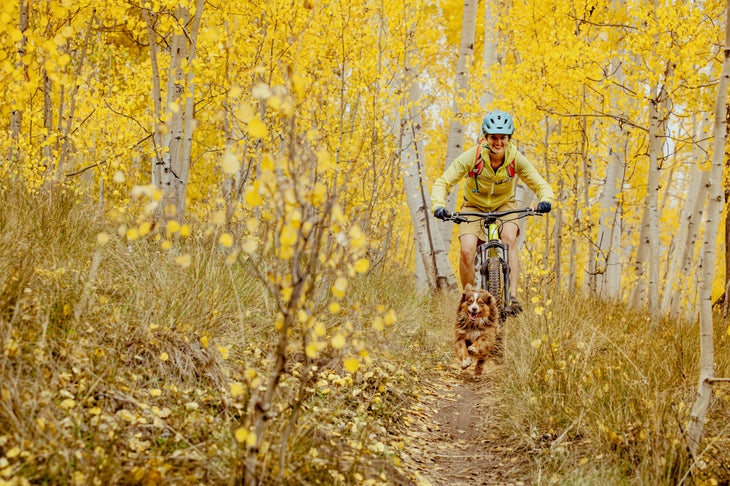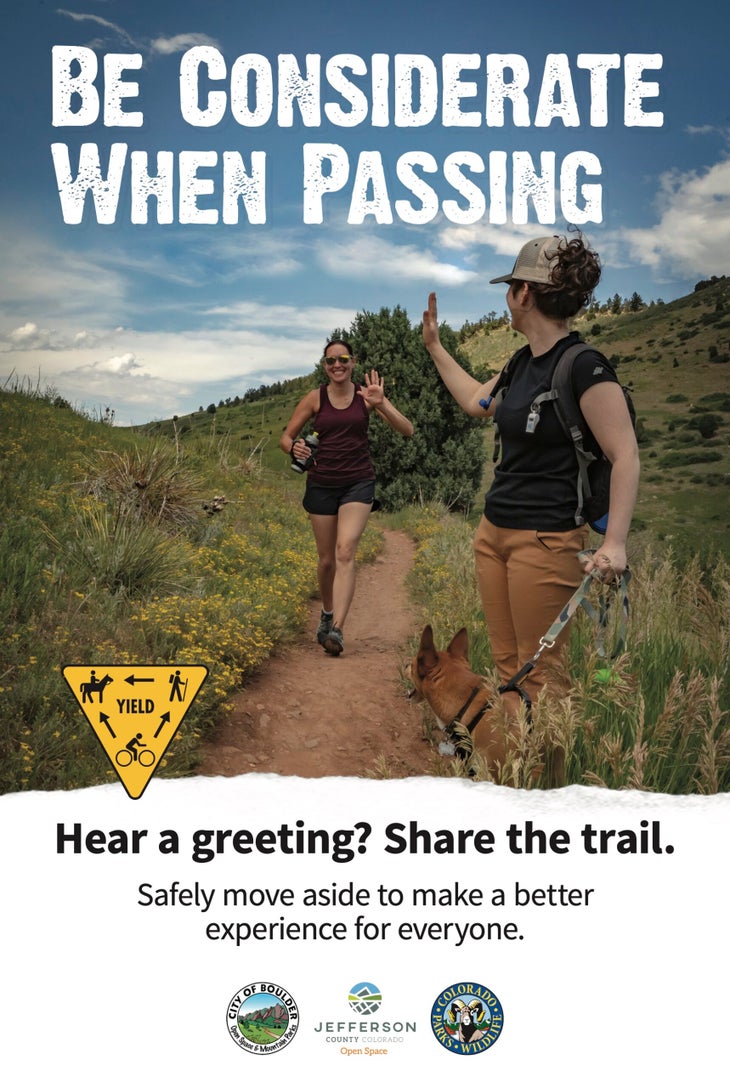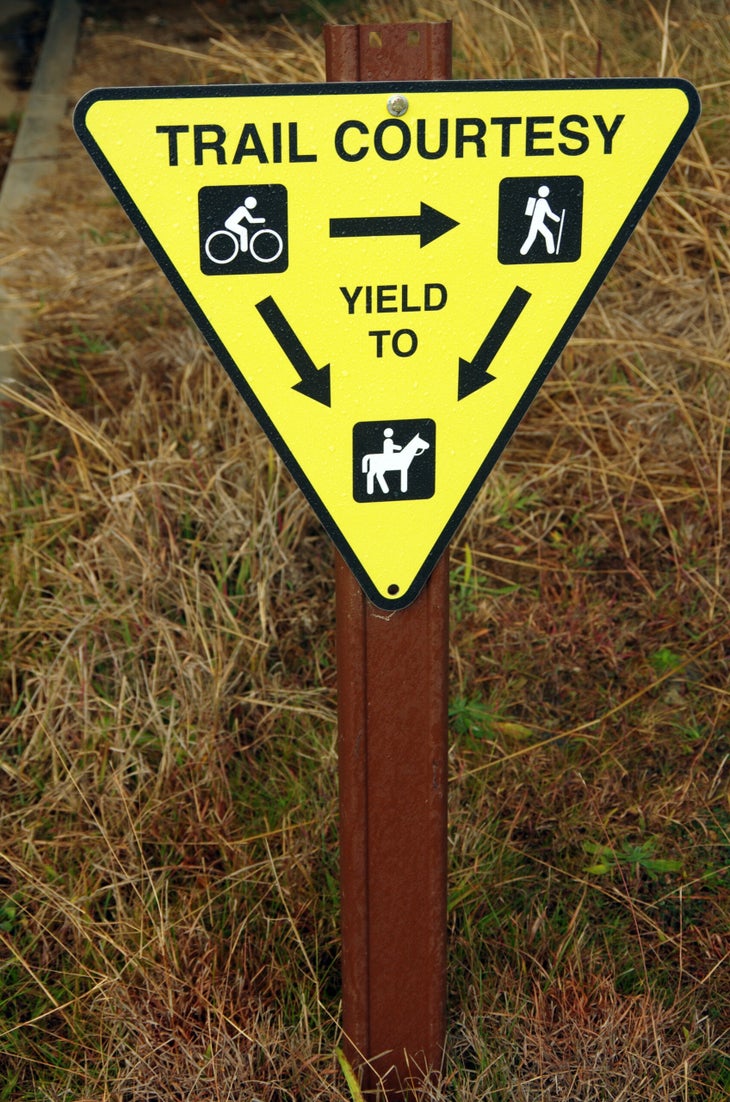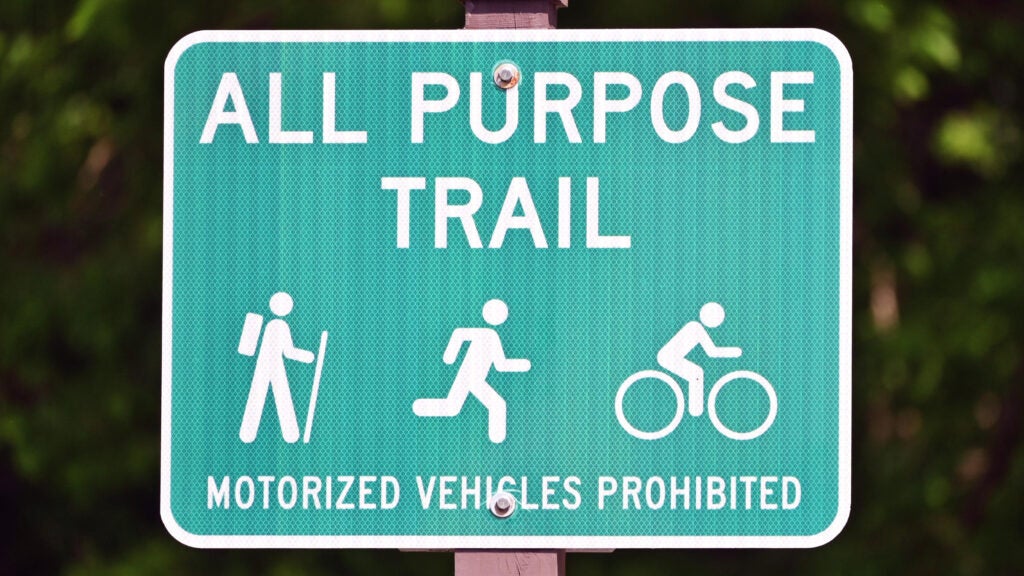Products You May Like
Heading out the door? Read this article on the new Outside+ app available now on iOS devices for members!
Download the app.
A few weeks ago, I was resting at the top of a climb on my mountain bike while my dog, Juno, sniffed around in the ferns, looking for puddles to lap up. From behind a stand of trees, we heard an unusual sound—something was moving toward us, fast. I leashed Juno just as a woman on a horse galloped into view, smiling and waving as she slowed to a walk.
On our local trail system, it’s common to see mountain bikes, off-leash dogs, runners, and hikers, but it was the first time I’d seen a horse there (and the first time my dog had seen one, ever). Juno wasn’t sure what to make of the creature, and the rider graciously stopped to let her take it in. As we chatted, Juno’s body language relaxed. After a few minutes we both moved on; it was one of the most pleasant, considerate interactions I’ve ever had with another trail user.
Unfortunately, encounters on multiuse trails don’t always go so smoothly. In areas where hikers, riders, and bikes congregate, tensions can run high. In the worst cases, discourteous interactions can lead to injuries on the trail from crashes or collisions. While directional trails, regulations, and yielding protocols can help keep the peace, there’s a pervasive sense of entitlement between user groups that we as hikers can help dismantle.
Single-use and alternating-use trails create more work for land managers in the form of signage, enforcement, and educating the public. As a result, hiking-only and multiuse trails make up the vast majority of singletrack across the country. Bike-only trails are hard to come by, yet many hikers balk at sharing the trail with even the most safety-conscious and considerate mountain bikers.

Boulder, Colorado—a hotspot of outdoor recreation—is a living example of the struggle for successfully shared trails. There, a trail-laden swath of land is home to the country’s longest-standing bike ban. Since the mid-1980s, the city has prohibited bikes on 70 miles of trail through the scenic Flatirons and foothills adjacent to town. According to the Boulder Mountain Bike Alliance, “the reasons given for the closure were the scientifically refuted claim that bikes cause more resource damage than hikers and worries of user conflict.”
Supporters of the bike ban claim that mountain bikes would pose safety issues for other trail users. But neighboring Jefferson County is proof that safe, successful multiuse trails are possible. Out of the 266 miles of trail in the Jefferson County Open Space (JCOS) system, 213 miles are multiuse. Bikes are prohibited on roughly 30 miles of trail, while less than 2 miles are designated as bikes only at the time of writing. (JCOS also implements alternating use—bikes-only one day, hikers the next—on about 20 miles of trail that are popular for both groups, and were previously a hotspot for conflict.) Since 2014, there have only been three reported collisions between trail users in the system that sees about 7 million visitors each year—one of which occurred when hikers entered a bike-only trail.
Lesser conflicts do occur. According to JCOS Visitor Services and Natural Resources Director Mary Ann Bonnell, the most common source of complaints is off-leash dogs.
Aside from providing outdoor access to more people, there are myriad benefits to keeping trails a shared experience between different user groups. “If you look at it through a habitat fragmentation lens, one trail that everyone uses fragments the habitat less than separate trails headed for the same destination,” says Bonnell. “If you look at it through a social carrying capacity lens, being considerate of other visitor types and their goals is an important skill we want park visitors to practice and eventually master.”

Promoting safety and courtesy on multiuse trails has been a priority for JCOS land managers. They use a variety of educational tools, from signage to community outreach talks, in order to reach recreationalists, and research shows that it’s working.
A 2022 study by JCOS, Boulder Parks and Recreation, and Colorado Parks and Wildlife demonstrated that when a courtesy sign was posted along the trail, mountain bikers were almost twice as likely to announce themselves as they approached a hiker, leading to safe and respectful interactions between trail users. While that’s a win in the short-term, the study concluded that signs won’t necessarily encourage long-term behavioral change. Bonnell says that changing biker and hiker behavior is a “slow burn.”
“One sign can’t be expected to do the job,” she says. “One sign complements other sustained efforts such as media outreach, trailhead education, park regulations, and conversations outside your visitor group echo chamber.”
As users, we can all do our part to make the trails a safe, welcoming place for all. Following yielding etiquette is a great place to start. Bikes should yield to both hikers and horses, and hikers should yield to horses. In general, uphill traffic has the right of way.

But, “strict interpretation of the yield triangle may not always be the safest or most considerate way to show trail courtesy,” says Bonnell. In many cases, it’s easier for a hiker to step aside to let a faster-moving cyclist pass.
According to Bonnell, it’s helpful for slower traffic to stay to the right, and to hike, run, or ride in single-file lines. Above all, pay attention to your surroundings. “Keep one earbud out,” says Bonnell. A vigilant mindset will serve you well hiking in any environment, but especially on multiuse trails. Heed signs indicating direction of travel, and never hike on a bike-only trail—you or others could get seriously hurt.
If you’re recreating with a pet, be sure to obey all leash rules. Even where dogs are allowed to roam free, it’s not always appropriate: Leash your dog in busy areas or if you’re unable to control their movements with voice commands. Keep dogs especially close when other trail users are passing.
At the end of the day, the key to successfully sharing the trail is courteous communication. If you’d like to pass another trail user, slow down and announce your presence first. When it’s safe to do so, it’s polite to let faster trail users pass.
“Reinforce good behavior,” says Bonnell. “Be sure you thank other visitors when they pass you with courtesy.”
If you still don’t want to share the trail, chances are there are plenty of hiking-only options in your area. Apps like TrailForks allow you to filter trails by user type, making it easier to avoid trails that are popular with bikes. You can also view map layers that show concentrations of bikers versus hikers.
And while some recreationalists maintain an air of superiority, it’s important to remember that different user groups share equal rights to multiuse trails. There’s no greater virtue in walking, rolling, riding, or any other form of movement. We’re all out here trying to enjoy nature in the ways that fulfill us. That was the case on that sunny day when I met the friendly horse and rider. Connecting with one another along the way was just an added bonus.
